 Environmental Cognition and Tsunami Evacuation Planning Environmental Cognition and Tsunami Evacuation Planning |
<Presented at the 44th Annual Conference of Environmental Design Research
Association, May. 2013>
<Special Issue of MERA Journal, pp. 20-23, Mar. 2014>
|
| Teruyuki Isagawa, Ryuzo Ohno |
|
The Great East Japan Earthquake caused massive tsunami and brought serious damage along the coast of eastern Japan. Since the delay of evacuation had caused many victims, importance of the behavior studies in field of disaster prevention measurement has been recognized. This study focuses on the effects of environmental factors such as topography or road network upon residents’ behavior. This knowledge will aid in the reconsideration of effective announcement and navigating evacuees in case of emergency.
In this study, we distributed questionnaire forms to all 2,272 households
in the coastal area of Onjuku, Chiba prefecture, where the large-scale
tsunami warning was issued. The questionnaire asked about their behavior
in the form of flowchart and mapping with which we can identify where they
were at the time of the earthquake and trace how they behaved after that
as well as the reason of their choice such as knowledge and information
used. With these, we aim to clarify the effects of environmental factors
on their decision-making and path choice behavior.
From the data, 447 valid responses (collection rate: 19.7%), large numbers
of residents did not evacuate although they had received the disaster information.
The results revealed that their decision-making was related to environmental
factors (such as an estimation of hazard areas, altitude), while their
belief was not always accurate. Our result also indicates importance of
considering various travel activities (e.g. stopping at home, going to
the coast, or picking up their children) when we discuss evacuation route.
|
Full paper → PDF
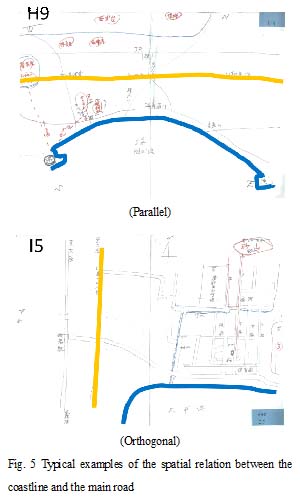 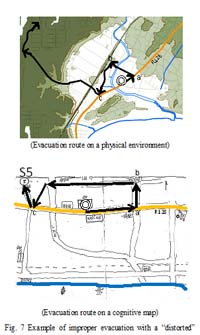 |
|
|
 Residents' Behavior in a Potential Area for Tsunami Disaster after the Great East Japan Earthquake
Residents' Behavior in a Potential Area for Tsunami Disaster after the Great East Japan Earthquake |
| <Presented at the International Association for People-Environment Studies
(IAPS22 Conference), Jun. 2012> |
|
Teruyuki Isagawa, Ryuzo Ohno
|
On March 11, 2011, Japan was hit by the Great East Japan Earthquake
that caused massive tsunami along the shore of Tohoku to Kanto region and
brought serious damage. More than 15,000 people were killed. Since the
delay of evacuation had caused many victims, importance of the behavior
studies in field of disaster prevention measurement has been recognized.
To understand how coastal residents made decision and how they behaved
at urgent situation become important because this knowledge will aid in
the reconsideration of effective announcement in case of emergency and
disaster education. Right after the earthquake, meteorological agency gave
a large-scale tsunami warning including the coast area of Onjuku town,
Chiba prefecture where the local government also issued an evacuation counsel
to coastal residents.
In this study, we distributed to all households in the coastal area of
Onjuku town, totally 2,272 questionnaire forms. We asked to respond only
who were in the town at the time of the earthquake. The questionnaire asked
about their behavior in the form of flowchart and mapping with which we
can identify where they were at the time of the earthquake and trace how
they behaved after that as well as the reason of their choice such as knowledge
and information used. With these, we aim to clarify the influential factors
on their decision-making and path choice.
From the data, 451 responses (collection rate: 19.8%), we analyzed residents'
behavioral patterns. As a result, respondents acquired information from
various source, while the degree of influence on decision-making varied
with what type of information and how they received. Behavioral patterns
are different according to the location and situation at the time of earthquake.
At the same time, we found some risky behaviors made by the residents;
some people came back to the home near the sea and others went to the seaside
to watch tsunami. |
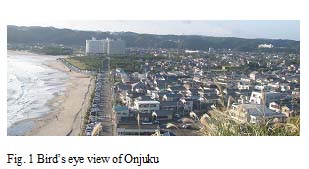 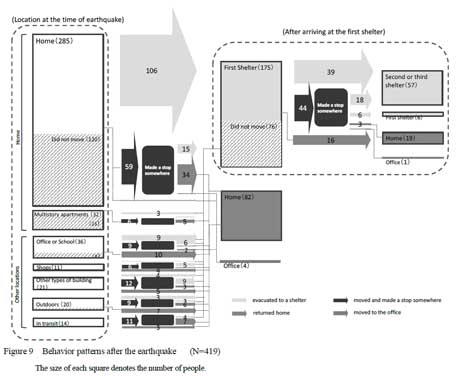 |
Full paper -> PDF (CUEE 2012, pp. 1923-1930)
 Influence of Fire Information and Architectural Space on Evacuation Decision-making Influence of Fire Information and Architectural Space on Evacuation Decision-making |
| <Proceedings of the 42nd Annual Conference of Environmental Design Research
Association, pp. 327-328, May. 2011> |
| Ryuzo Ohno, Atsushi Hikita |
|
In a fire, the “normalcy bias” makes people tend to
ignore emergency announcements and waste critical time before they start to
evacuate. Most previous research on fire evacuation has dealt with
architectural solutions for smoothing movement after people decide to
take action. The present study focuses instead on the process leading up to the
decision to evacuate, examining how it is influenced by the kinds of fire
information people receive and the characteristics of the architectural space
they are in. For the study, a virtual office room was created inside an
audio-visual simulation laboratory using images projected on three front
screens (each 2 meters square) covering a 180-degree visual field. The 26
subjects were asked to imagine they had come to this room to perform routine
computer tasks. Nine scenarios (settings) combined five patterns of fire
information with three types of architectural space, and the subjects acted as
they would under each situation; they could, for example, “move” out of the
room to see what was happening outside by flipping a switch to change the
images projected onscreen. All actions were recorded with a video camera until
the subject declared that he/she had decided to evacuate, at which point the
experiment was terminated. Findings revealed that 1) hearing a fire alarm and a
fire-alarm warning prior to the actual fire announcement encourages earlier
decision-making, 2) persistent repeating of fire alarms and announcements is
effective in prompting people to investigate their surroundings and therefore
decide to evacuate, and 3) decision-making tends to be delayed in a room with
no windows along the corridor and higher sound insulation, whereas it is
speeded in a room with a corridor-side window or a nearby void space that
allows people to more easily see what is going on.
|
Full paper → PDF
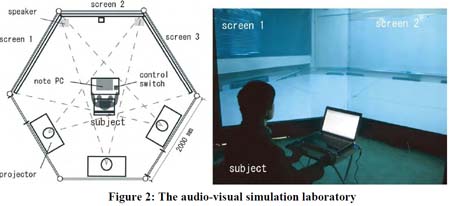
 |
    |
|
 Effect of Wording of Fire Warning Announcements on Evacuation Behavior in Subway Stations
Effect of Wording of Fire Warning Announcements on Evacuation Behavior in Subway Stations |
| <Proceedings of the EDRAMOVE intensive: Movement and Orientation in
Built Environments, pp. 59-65, May. 2008.> |
|
Ryuzo Ohno, Hidekazu Tamaki, and Masashi Soda
|
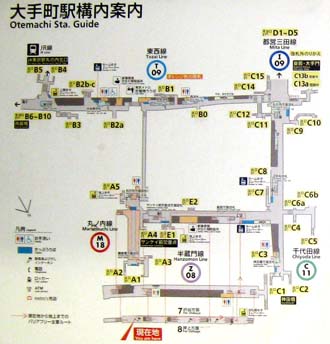  |
Generally speaking, fire protection has not been considered as great
a priority in subway stations as in other urban public facilities because
they are assumed to have fewer fire hazards. However, several major subway
disasters have occurred in recent years, such as the fire caused by a suicidal
man at a subway station in Taegu, Korea, that took 192 lives in 2003 and
the terrorist bombings on the London Underground in 2005. Since people
tend to follow the flow of the crowd in emergencies, it is important for
them to be led in the appropriate direction in the early stages of evacuation.
Although in the case of subways, station staffs are expected to provide
this guidance, the number of personnel available in any one place is limited,
and those who are on hand may not always be fully informed of the overall
situation. One possible solution is to make better use of loudspeaker systems,
recent technological advancements in which afford precise control of the
area and direction covered by individual units, making it possible to tailor
warning announcements to the layout and signs of specific locations in
the station. The present study experimentally examines how the wording
of broadcast warning announcements combines with the effects of nearby
spatial features and signs to influence evacuation behavior at subway stations.
A series of experiments was conducted in an existing Tokyo subway station
at five settings, each with a different stair and sign layout. For each
session, the subjects (13 male and 8 female university students) were asked
to listen twice through headphones to a recorded announcement played over
a portable voice recorder, then to start heading in whichever direction
they believed safest. Experimenters followed them to record their behavior
until they started to go up/down a stair, at which point the subjects were
asked why they chose that route.
The following results were obtained by the study: (1) After hearing announcements
that do not give any directional instructions, subjects tend to choose
their way according to prominent spatial features (most notably upward
stairs) and exit signs or, in the absence of such physical cues, to rely
on their own behavioral history. (2) Subjects tend to feel uneasy about
and sometimes distrust announcements that direct them downstairs, unless
the instructions indicate that going downstairs first is necessary to eventually
reach the exit. (3) Similarly, when subjects hear an announcement that
leads them in the same direction as the location of the fire, they tend
to feel uneasy and reluctant unless they are given more details about the
situation. These results point to possible problems with recently built
or remodeled stations in Tokyo that are designed to have one concentrated
ticket area shared by several subway lines of different depths, so that
some platforms have only downward stairs leading to the exit. Such unintuitive
layouts may result in dangerous confusion for evacuees in an emergency
situation.
Proceedings → PDF file(extended abstract) |
TOPへ
|